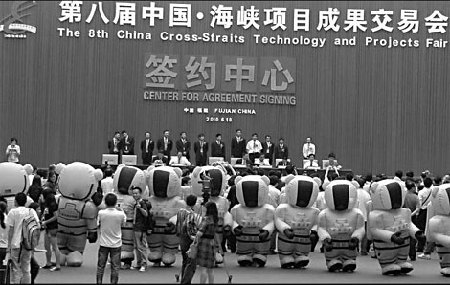|
 |
|
The opening ceremony of the Cross-Straits Technology and Projects Fair, known as 6.18 because of its opening date. The annual fair, now in its eighth year, this year featured a low carbon concept. Organizers set up an exhibition area to specially showcase Fujian province's technical innovation and successful examples of new material, new energy and energy-saving industries.
|
While Shanghai Expo 2010 is demonstrating the world's wisdom in making a greener planet, another fair in the East China city of Fuzhou has been converting some of the country's technical innovations into reality as a way of showing its commitment to building a greener economy.
The Cross Straits Technology and Projects Fair, known as 6.18 because of its opening date, is the eighth of its kind. However, this year is the first time that the annual event in the capital of Fujian province has featured a low carbon concept and set up an exhibition area to specially showcase the region's technical innovation and successful examples of new material, new energy and energy-saving industries.
"Fujian possesses large reserves of renewable energies such as solar, wind, biomass, and tide," said Zhao Linru, president of Fujian International Chamber of Commerce, "This is fundamental for the region to conduct global energy cooperation and benefit both its economy and environment."
The 6.18 provides a platform for holders of technology patents to look for potential markets as well as for companies to seek help from experts in tackling technical difficulties.
A total of 681 docking projects, with a value of 17.05 billion yuan, were agreed at this year's fair - a 2.79 billion yuan increase, or 19.6 percent, up on last year. Meanwhile, the fair has put on show more than 6,000 technical achievements and acquired 900 business technology needs from enterprises, among which more than 10 percents were related to new materials, energy saving and environmental protection.
The technology needs collected will be sent to selected universities and research institutes where solutions will be sought, officials said. They added that settlement of such technical requirements, common ones in particular, would play a positive role in breaking the "bottleneck" in raising the technology level of industries and accelerating the upgrading of products.
|
